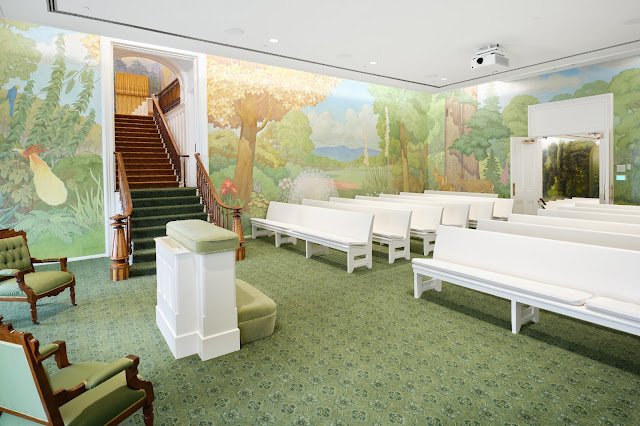Photos were posted today of the completed Manti Temple renovation. All of the photos below come from Church Newsroom.
I'm very, very happy about this renovation. It seems they were able to keep everything that makes this temple unique, with the exception of the live endowment.
The annex looks much the same; a historically accurate green color is on the walls. You can see that Isaac Morley's temple apron is still hanging at the end of the annex.
In the chapel, John Hafen's 1906 painting (a copy of Benard Plockhorst's Jesus Blessing the Children) still remains at the front of the chapel:
In keeping with the Church's Christ-centric focus, especially in temples, the Christensen mural of the Manti Temple in the lobby has been replaced with a beautiful painting of Christ as a shepherd. I'm assuming the Manti Temple mural is elsewhere in the building. Beneath the painting, the Logan Temple sacrament table still remains.
In the baptistry, the murals of Christ and Joseph Smith's baptism were added by Robert L. Shepehrd in 1946. In 1982, the scriptural quotations were added by Wes Wright.
The mural even extends to the ceiling above the font.
In the ordinance room, the Church has kept the original murals as well as the benches. I was particularly happy that they kept the benches, as it adds some authenticity to the endowment experience. While the film presentation is now used, they added it with projectors and screens that come down from the ceiling, leaving the walls undisturbed.
I had assumed that there would be some kind of equipment in place to make the endowment rooms more accessible--like ramps or lifts. It appears that after some study, the Church decided it would cause too much damage, and so it must still be difficult to complete an endowment session if you have accessibility concerns. (In one session I attended, they recruited 4 brothers to carry a woman up the stairs in her wheelchair.) However, with the Ephraim Temple being built 15 minutes up the road, no one in the valley should have issues completing temple ordinances.
The oldest temple mural in use, C.C.A. Christensen's 1886 mural in the creation room, remains. I had read in another source that the Church planned to remove it and repaint it during the course of the renovation, but it appears that they decided to keep it. This was the most difficult one, since it was painted directly on the plaster (not on canvas like the other ordinance room murals). They said they even found a few animals in cleaning it that you couldn't see before.
It's so nice to have this mural in place!
The garden room's mural, Robert Shepherd's 1944 garden mural has been preserved. The screens at the front, used by actors in the live endomwent, are gone. Also, heavy curtains (that presumably close when needed) have been added to windows in this and the world room; before, there were only sheer ones.
The celestial room looks the same, and it looks like it's kept much of the same furniture as it did before:
Several sealing room images were provided, although I'm less familiar with these and can't pinpoint their locations as well. Some are in the annex, and smaller ones are off of the celestial room. If I had to guess, I think the first sealing room pictured here is one of the smaller ones in the east tower (added in the 1980s renovation), the second one is in the annex (also added in the 1980s), and the last one is on the same floor as the celestial room.
The sealing room just off the Celestial Room--which serves as the temple's Holy of Holies--has also been beautifully preserved:
Finally, the Church provided images of the spiral staircases and the assembly room. Both look in great shape. In the assembly room, they've kept most of the floor uncovered, using just runners in the aisles, as before.
The benches face toward the Melchizedek Priesthood pulpits on the temple's east side. This side includes a microphone, speakers, and an organ:
The Aaronic Priesthood pulpits, seen here, are on the west side, but look exactly the same. After the Kirtland and St. George Temples, assembly room pulpits didn't have initials for priesthood offices.
Nearly everything in this room, except for the carper runners and some upholstery, is original. Even the panes of glass. No curtains are needed in this room, and participants can see a beautiful view of the Sanpete Valley.
It will be fantastic to see the open spiral staircases in-person again.
I'm very happy with this remodel. I wish a similar remodel could have been done to the Salt Lake Temple (or even the St. George Temple), but at least the Manti Temple remains the best way to see pioneer temple architecture.

















.jpeg)
.jpeg)






.jpeg)










